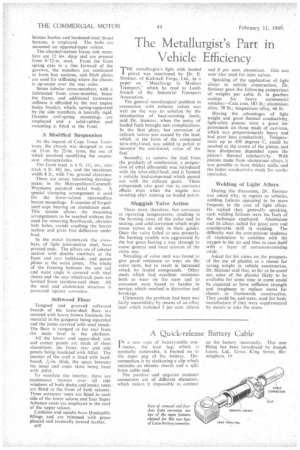New Daimler Six-wheeler for 84 Passengers
Page 17

Page 18

If you've noticed an error in this article please click here to report it so we can fix it.
ALTHOUGH a Daimler sixwheeled bus was produced before the war and successfully completed a full operational life in public service, an order from Cape Town Tramways for 20 three-axled chassis to carry 64-seater bodies, with room for 20 standing passengers, of necessity involved designing a new vehicle to make the greatest possible use of standard components, in the interests of service and repair facilities.
The new chassis, briefly described in "The Commercial Motor" last week, is in many respects similar to that of the Daimler trolleybus, in that it has a standard Kirkstall rear bogie, a Westinghouse compressed-air b rakin g system and identical three-start worm -leering gear. The frame has been reinforced to meet the altered distribution of torque stresses and major modifications have been introduced to accommodate the power unit and gearbox.
In much of the development work. the designers of Transport Vehicles (Daimler), Ltd., Coventry, co-operated with Mr. Andrew Fenwick, general manager of Cape Town Tramways.
Designated the CVG 6/6 DID, the latest chassis is powered by a Gardner 6LW oil engine developing 102 b.h.p. at 1,700 r.p.m. The radiator is of the latest flexi-joint pattern of large capacity, with easily detachable top and bottom tanks, and is fitted with fullheight cast brackets which are attached to the frame members by flexible mountings.
Departing from Gardner practice, the dynamo drive is taken from the near side of the timing case and the air compressor is mounted in the former position of the dynamo, and driven through twin belts and pulleys from th.! front of the gearbox.
The transmission incorporates a standard open-circuit type of fluid coupling, Wilson epicyclic gearbox and tubular propeller shafts fitted with Hardy Spicer ioints. Grease shields are mounted adjacent to the universal joints to prevent excess lubricant being thrown on the body under-framing.
The Westinghouse braking system employs a compressor, with a displace
ment of 5 cubic ft. of air per minute at working pressure, which is fitted with an air silencer and anti-freezer. The com pressor governor, mounted on the off side of the chassis in an accessible position, is set to operate at 75-110 lb. per sq. in., and is fitted with a blow-off safety valve, A gauge in the driver's cab indicates the reservoir pressure, whilst a second gauge shows the pressure in the six operating cylinders.
The brake shoes are 31 ins, wide on the front wheels and 6 ins, wide on the bogie, giving a total frictional area of 913 sq. ins. Adjustment is effected manually.
The semi-elliptic front springs have rolled eyes and plain bushes, and the shackle pins can be turned through 150 degrees to increase their, useful life. Spring action is controlled by Luvax Girling P.7 piston-type shock absorbers A Daimler front axle of H section, with tapered swivel pins. phosphore9 bronze bushes and-hardened-steel thrust buttons, is employed. The hubs are mounted on opposed-taper rollers.
1 he channel-section frame side members are 12 ins, deep and are pressed from 9/32-in. steel. From the front spring eyes to a line forward of the gearbox, the members are reinforced to form box sections, and flitch plates are used for stiffening where the chassis is up-swept over the rear axles.
Seven tubular cross-members, with a fabricated front cross-member, brace the frame, and additional transverse stiffness is afforded by the rear engine banjo bracket, which, spring-supported by the side members, is laterally rigid. Daimler coil-spring mountings are employed and a solid-rubber pad mounting is fitted at the front.
A Modified Suspension At the request of Cape Town Tramways, the chassis was designed to rim on 11-in. by 22-in. tyres, the use of which involved modifying the suspension characteristics.
The front track is 6 ft. 11 ins., rear track 6 ft. IN ins., and the maximum width 8 ft., with 7-in, ground clearance.
There are many interesting developments in the Metropolitan-CammellWeymann patented metal body. A special clamping arrangement is used for the lower-saloon intermediate bearer mountings. It consists of forgedsteel caps bearing on aluminium pads. This system allows the mounting arrangements to be reached without the need for removing floorboards, obviates bolt holes, avoids crushing the bearer section and gives free deflection under load.
In the metal framework the crossbars, -of light joist-section steel, have pivoted ends. The pillars are of tubular section with double members at the frpnt and rear bulkheads, and gusset plates at the waist joints. The whole of the framing between the seat rail and waist angle is covered with steel sheets and the rear wheel-arch pans are formed from stainless-steel sheet. All the steel and aluminium structure is protected against corrosion.
Softwood Floor
Tongued and grooved, softwood boards of the lower-deck floor are covered with heavy brown linoleum, the material in the gangway being separated and the joints covered with steel treads. The floor is ramped at the rear from the main level to the platform.
All' the lowerand upper-deck side and corner panels are made of sheet aluminium, the front, rear and side panels being insulated•with Alfol. The interior of the roof is lined with hard board, thick, the space between the inner and outer skins being lined with Alfol.
To ventilate the interior, there are continuous louvres over all side windows of both decks, and intake vents are fitted at the front of both saloons. Three extractor vents are fitted .to each side of the lower saloon and four Super Ashanco vents are employed in the roof of the upper saloon.
Cushions and squabs have Dunlopillo fillings and are trimmed with green pleated and tropically treated leather.
B 0


























